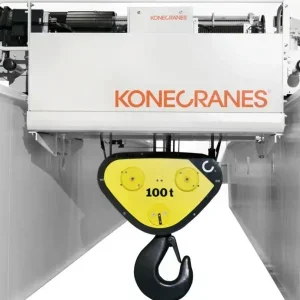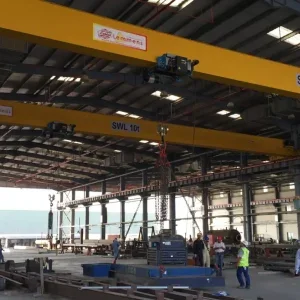Of a small number of UK lifting equipment training companies offering their services on the international stage, Biglift is certainly one of the newest.
Established six years ago, the company has grown consistently despite the recession to develop into an organisation offering a variety of services to an international clientele, including petrochemical giants BP and Shell.
Initially specialising solely in lifting equipment operation, examination, and lifting supervision training, the firm has begun developing branches of the company specialised in providing engineered solutions and contract lifting support.
This is in no small part due to Biglift’s managing director, Sean McLaughlin, having extensive experience in the materials handling industry.
A veteran of UK crane hire firm Ainscough, McLaughlin says his time at the firm opened his eyes to some client needs and opportunities for his company to fulfil on the international stage.
McLaughlin says: “It put me in touch with a large number of people, manufacturers of cranes, wire rope manufacturers, people like that. So they knew who I was in the industry, it was a natural partnership with a lot of the companies.
“When I started, I identified that there was a big opportunity and a big need for providing cranes and lifting equipment training and examinations worldwide. Certainly, from the enquiries that I have had from the companies that I work with, there was more and more cranes, plant and equipment that was going overseas than there probably was in the UK.
“So that was an area that I wanted to tap into, and I was quite clear from the outset that I didn’t want to be just a run of the mill provider in the UK, I wanted to provide a good quality service worldwide.”
The firm is currently focused on working across west, central, and northern Africa in countries like Gabon and Libya. Currently in Angola, Biglift has been contracted by inspection and survey specialists Bureau Veritas to train 15 local engineers in everything from the correct use, calibration and inspection of lifting tackle, to the operation of mobile crane and pedestal crane on-board computers.
In Africa, with countries like Libya and Nigeria keen to capitalise on their bountiful natural resources, extensive on and offshore mining and petrochemical operations require a constant supply of lifting equipment to support such operations.
Of course this necessitates a highly technically trained work force for their operation and maintenance, and it is this need that has brought Biglift to an arena that many other companies shun.
“In Africa, because there’s a lot of offshore, marine, petrochemical type activities, mining etc, it’s very heavy engineering. A lot of the equipment is very big robust equipment subject to a lot of outside factors like corrosion, and overloading of equipment.
“It’s very important for the clients we have, like BP, Shell and the drilling companies of the world, that the equipment is in good condition and verified.
“Companies have these assets, some of these offshore pedestal cranes and mobile cranes are probably €2m to €2.5m or higher, and they’re quite conscious that they need to have systems and procedures in place and properly trained people planning and supervising the lifts.”
The difficulties facing many companies carrying out operations in Africa, where the construction industry is showing rapid levels of growth, are varied.
From logistical support to the training of workers who speak a variety of languages and dialects, African nations throw up a range of problems for construction projects that many companies may not used to dealing with without the support of a transport system or a training framework as well-developed as in other countries.
“What we’re trying to do is build a reputation up for problem solving, and take on projects that other companies maybe shy away from,” says McLaughlin.
“We will deliver the training or the expertise that we have pretty much anywhere in the world. It’s very difficult to try and find locally, or through other countries, people that can offer these types of services for this type of training. There aren’t that many of us around.
“We are getting asked to do things more and more in areas of countries where things may be a logistical nightmare, or where there might be a lot of problems that need to be overcome with the technical aspects.
“Designing and building things or finding a solution to problems, that’s what we are building a reputation for now. People have the confidence in us that if we’re in places like Uganda, or in the back of beyond in the jungle or the desert somewhere, things don’t necessarily need to come to a grinding halt, there is a company that can provide expertise and solutions to problems locally.”
This attitude has seen Biglift’s engineered solutions arm of the company grow to comprise 30% of the business in little over a year.
More recently, in addition to the basic training programmes for safe lifting equipment operation, Biglift has now focused on higher-level management of lifts with a recently introduced NVQ level 6 course in lift planning and supervision.
The course will provide training on every aspect of lift planning for a range of lifting machinery, from mobile cranes and tower cranes, to industrial lifting operations.
It includes training on the production of method statements, risk assessments, performing technical calculations and correctly selecting lifting tackle.
With many of Biglift’s training programmes already accredited by Construction Skills and LEEA, the demand for this quality of training abroad is certainly there.
However, what McLaughlin wants to focus on next is the practicalities of delivering that technical training and navigating around the problems unique to different environments.
To this end Biglift are working to develop a transportable virtual reality construction environment simulator, which can allow trainees to familiarise themselves with a range of lifting gear while removing the practical and environmental limitations of more traditional training environments.
McLaughlin explains: “For the more technical based courses, and crane inspection courses, we can incorporate a virtual world into that course where they can do a lot of the foundation training with the simulator itself.”
Sean believes this is ideal for hazardous environments such as offshore rigs where access to certain equipment in poor weather conditions can delay training.
Using a 3-D simulator, a photo-realistic, interactive 3-D model of a piece of equipment can be examined and broken down to its constituent components to familiarise trainees with what to look for during inspections.
McLaughlin hopes it can also help to break down language barriers in some of the regions he works in, while making the training more fun and accessible.
“The development of the simulator is going really well at the moment, and it will eventually help us paint a picture of 1,000 words basically. We’re looking at possible partnerships with universities that want to get involved with building a simulator for apprenticeships for engineers.”






